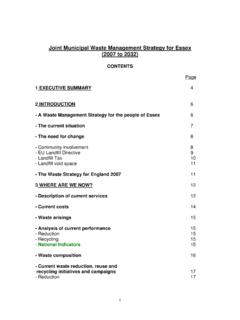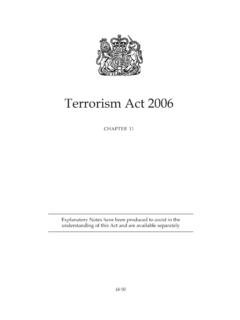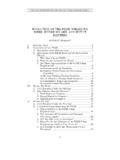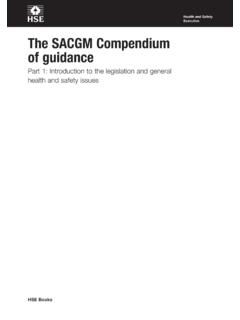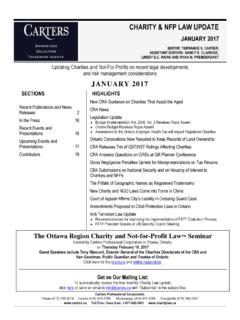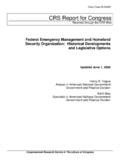Transcription of Civil Contingencies Act 2004: a short guide (revised)
1 Civil Contingencies Secretariat Civil Contingencies Act 2004 : a short guide (revised) Background Following the fuel crisis and the severe flooding in the autumn and winter of 2000 and the outbreak of Foot and Mouth Disease in 2001, the Deputy Prime Minister announced a review of emergency planning arrangements. The review included a public consultation exercise which reinforced the Government s conclusion that existing legislation no longer provided an adequate framework for modern Civil protection efforts and that new legislation was needed. Following public consultation on a draft Bill from June to September 2003 and pre-legislative scrutiny by a Joint Parliamentary Committee, the Civil Contingencies Bill was introduced to Parliament on 7 January 2004 . Its development was informed from the start by close consultation with key stakeholders in what was an open and inclusive policy-making process.
2 The Bill received Royal Assent on 18 November 2004 and henceforth became known as the Civil Contingencies Act 2004 (the Act ). This guide gives a brief overview of the main provisions of the Act. Overview of the Act The Act, and accompanying regulations and non-legislative measures, will deliver a single framework for Civil protection in the United Kingdom capable of meeting the challenges of the twenty-first century. The Act is separated into two substantive parts: Part 1: focuses on local arrangements for Civil protection, establishing a statutory framework of roles and responsibilities for local responders. Part 2: focuses on emergency powers, establishing a modern framework for the use of special legislative measures that might be necessary to deal with the effects of the most serious emergencies. Key to modernising existing legislation is updating the definition of what constitutes an emergency.
3 Definition of Emergency Civil Protection activity at the local level previously took place under Civil Defence legislation dating from 1948. This legislation defined the events local responders should prepare for in terms of hostile attack from a foreign power. With the ending of the Cold War such a threat evaporated and local efforts have been focused on preparing for Civil emergencies such as localised flooding and major transport accidents. Emergency Powers legislation is older still. The Emergency Powers Act 1920 defines an emergency in terms of interference with specified services and resources which will deprive the community of the essentials of life. A great deal has changed since 1920. The list of services and resources in the 1920 Act was out of date. In addition, the focus of the 1920 Act on essential services and resources failed to reflect the kinds of emergency which the UK now faces (for example, the 1920 Act did not clearly cover terrorist threats or threats to the environment).
4 In modernising the legislation, it was necessary to introduce a new updated definition of an emergency which focuses on the risks we face in the 21st century. The definition of emergency in the Act focuses on the consequences of emergencies. It defines an emergency as: an event or situation which threatens serious damage to human welfare; an event or situation which threatens serious damage to the environment; or war, or terrorism, which threatens serious damage to security. For Part 1 of the Act the definition sets out the range of possible incidents for which local responders must prepare when fulfilling their Civil protection duties. For Part 2 it sets out the situations in which it may be possible to use emergency powers if the appropriate safeguards are met. This does not mean that the definition of emergency is the same in both Parts. In Part 1, the threat must pose a threat of serious damage to human welfare or the environment of a place in the United Kingdom.
5 This reflects the fact that Part 1 is designed to deal with preparations by local responders for localised emergencies. In Part 2, the threat must pose a threat of serious damage to human welfare or the environment of one of the English Regions, or one of the other constituent parts of the UK (Scotland, Wales or Northern Ireland). This higher threshold reflects the fact that Part 2 is designed for use in very serious emergencies which affect a larger geographical area. Part 1: local arrangements for Civil protection The purpose of Part 1 of the Act is to establish a new statutory framework for Civil protection at the local level. Local responders are the building block of resilience in the UK, and the Act will enhance existing arrangements by: Establishing a clear set of roles and responsibilities for local responders; Giving greater structure and consistency to local Civil protection activity; and Establishing a sound basis for performance management at a local level.
6 The Act divides local responders into two categories depending on the extent of their involvement in Civil protection work, and places a proportionate set of duties on each. Category 1 responders are those organisations at the core of emergency response ( emergency services, local authorities). Category 1 responders are subject to the full set of Civil protection duties. They are required to: Assess the risk of emergencies occurring and use this to inform contingency planning; Put in place emergency plans; Put in place Business Continuity Management arrangements; Put in place arrangements to make information available to the public about Civil protection matters and maintain arrangements to warn, inform and advise the public in the event of an emergency; Share information with other local responders to enhance co-ordination; Co-operate with other local responders to enhance co-ordination and efficiency; and Provide advice and assistance to businesses and voluntary organisations about business continuity management (Local Authorities only).
7 The definition of emergency in the Act defines the sorts of events or situations that Category 1 responders should be preparing for. Section 2 of the Act additionally establishes a threshold that events or situations would need to meet to constitute an emergency, and thus to trigger the duties in Part 1 of the Act. This provides that Category 1 responders duties under the Act only apply to events or situations which require the use of assets beyond the scope of normal operations and require a special deployment. Category 2 organisations ( Health and Safety Executive, transport and utility companies) are "co-operating bodies" who while less likely to be involved in the heart of planning work, will be heavily involved in incidents that affect their sector. Category 2 responders have a lesser set of duties co-operating and sharing relevant information with other Category 1 and 2 responders. The detail of what this means in practical terms is fleshed out in the Contingency Planning Regulations 2005 and statutory guidance Emergency Preparedness which can be found at Category 1 and 2 responders are also required to come together to form Local Resilience Forums (based on police force areas outside London) which will help co-ordination and co-operation between responders at the local level.
8 A full list of Category 1 and 2 responders can be found at Annex A. The Act enables the Minister to alter the membership of both Categories of responder in order to ensure flexibility and to take account of future developments. The bulk of the duties in Part 1 of the Act came fully into force on 14 November 2005, with the duty on local authorities to give business continuity advice being implemented on 15 May 2006. Part 2: emergency powers In the UK emergency powers allow the making of special temporary legislation to deal with the most serious of emergencies. They are not a means for instigating martial law, for undermining Parliament, banning political parties or anything else of that nature. An essential point to note is that Emergency Powers legislation is a mechanism for dealing with only the most serious of emergencies that require an urgent response, an instrument of last resort. The previous emergency powers legislation (the Emergency Powers Act 1920) was used twelve times in its eighty-four year history, the last time being in 1974.
9 In the years since, a considerable amount of sector specific emergency legislation has been introduced which reduced the need to resort to emergency powers, in part because of a recognition that Emergency Powers legislation was inadequate. Nevertheless, there is still a need for a latent capacity to rapidly make new temporary statutory provision where this is the most effective way of enabling the resolution of an emergency situation. The Government needs a tool that can be deployed to address all forms of disruptive challenge where existing legislation is insufficient. The Act repeals the existing legislation (the Emergency Powers Act 1920 and its Northern Ireland counterpart, the Emergency Powers Act (Northern Ireland) 1926), and the emergency powers provisions of the Act extend to the whole of the UK. It sets out a new definition of what constitutes an emergency appropriate to the times in which we live and incorporating new risks and threats which were not so relevant in 1920, including terrorist attacks, contamination of land following a biological or chemical terrorist attack and loss of communications systems on which we now depend.
10 As with the 1920 Act, the Act allows the making of temporary special legislation aimed at dealing with a serious emergency that fits within the definition. The Queen, as Head of State, will formally indicate that emergency powers are necessary as part of the Order in Council that makes the regulations themselves. For the first time a fallback option has been included to cover the possibility that emergency powers will be needed, where the Queen is, for whatever reason, unable to act. The Act therefore allows for a senior Minister or the Prime Minister to make the regulations in the unlikely event that Her Majesty is not able to do so. The Act introduces a range of other new features, mostly designed to ensure emergency powers cannot be misused and can be used in a more targeted and proportionate manner. The centre piece of these is the triple lock , which ensures emergency powers will only be available if: an emergency that threatens serious damage to human welfare, the environment or security has occurred, is occurring or is about to occur; it is necessary to make provision urgently in order to resolve the emergency as existing powers are insufficient and it is not possible to bring forward a Bill in the usual way because of the need to act urgently; and emergency regulations must be proportionate to the aspect or effect of the emergency they are directed at.


